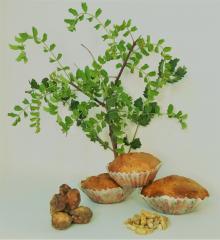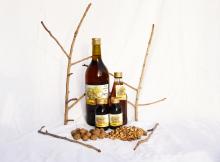Known internationally by its South African name, marula, Sclerocarya birrea is a food tree believed to have been in use for over 10,000 years.1 Today, it is exported for oils and of luxury liqueurs from countries such as Botswana, Namibia and South Africa, but remains little exploited in West Africa. This deciduous tree almost miraculously bears juicy fruits when the dry season draws to a close, in May and June.2 This is a period when cereal stocks begin to run low, when Sahelian nature produces little and where rural populations are in need of food and income. The pulp of ripe fruit has a delicious sweet and tart flavor. It contains a concentration of vitamin C three to four times higher than that of an orange,3 and is rich in antioxidants and calcium4. The nut, also with a noble taste, is calorific, containing 700 calories per 100g. It is rich in oil (47%), protein (36%), copper, magnesium and zinc.5 The profile of these fatty acids is similar to that of olive oil, with a high content of mono-fatty acids. unsaturated.6 The leaves are frequently used when young in cooking, and with their 74% carbohydrate by dry weight,7 helps people during the lean season. They are also recommended by doctors as an anti-hyperglycaemic product for diabetics.8 Walnuts can be stored for years unshelled, and this makes them an excellent potential food reserve for years of drought and famine.
Marula grows naturally throughout virtually all of sub-Saharan Africa, between isohyets of 200 and 1000mm. However, it has made a lot of decline in the Sahel during the last century due to its excessive cutting and the exploitation of its bark for medicinal purposes. The plant is dioecious, meaning that its subjects are divided into male and female trees. It is important to raise people's awareness of this phenomenon, otherwise they risk cutting down trees that do not bear fruit but are necessary for pollination.
1Hall, J. B. 2002. Sclerocarya birrea (A.Rich.) Hochst. [Internet] Record from PROTA4U. Oyen, L.P.A. & Lemmens, R.H.M.J. (Editors). PROTA (Plant Resources of Tropical Africa / Ressources végétales de l’Afrique tropicale), Wageningen, Netherlands. (en français et en anglais)
2Josef Garvi, directeur Sahara-Sahel Foods, observ. pers.
3National Research Council. 2008. Lost Crops of Africa. Volume III: Fruits, Washington, D.C.: The National Academies Press.
4 Hassan L.G., Dangoggo S.M., Hassan S.W., Muhammad, S. Umar K.J. 2010. Nutritional and Antinutritional Composition of Sclerocarya birrea Fruit Juice. Nigerian Journal of Basic and Applied Science (2010), 18(2): 222-228.
5 Glew R.S., VanderJagt D.J., Huang Y.-S., Chuang L.-T., Bosse R., Glew R.H. 2003. Nutritional analysis of the edible pit of Sclerocarya birrea in the Republic of Niger (daniya, Hausa). Journal of Food Composition and Analysis 17 (2004) 99–111.
6National Research Council. 2008. Lost Crops of Africa. Volume III: Fruits, Washington, D.C.: The National Academies Press.
7Eurofins nutritional analysis ordered by Sahara Sahel Foods, 2014.
8Dr. Soumana Karimou. 2014. Personal communication.



